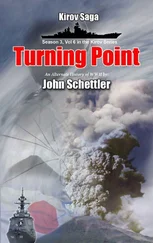John Schettler - Kirov
Здесь есть возможность читать онлайн «John Schettler - Kirov» весь текст электронной книги совершенно бесплатно (целиком полную версию без сокращений). В некоторых случаях можно слушать аудио, скачать через торрент в формате fb2 и присутствует краткое содержание. Жанр: Фантастика и фэнтези, Альтернативная история, на английском языке. Описание произведения, (предисловие) а так же отзывы посетителей доступны на портале библиотеки ЛибКат.
- Название:Kirov
- Автор:
- Жанр:
- Год:неизвестен
- ISBN:нет данных
- Рейтинг книги:5 / 5. Голосов: 1
-
Избранное:Добавить в избранное
- Отзывы:
-
Ваша оценка:
- 100
- 1
- 2
- 3
- 4
- 5
Kirov: краткое содержание, описание и аннотация
Предлагаем к чтению аннотацию, описание, краткое содержание или предисловие (зависит от того, что написал сам автор книги «Kirov»). Если вы не нашли необходимую информацию о книге — напишите в комментариях, мы постараемся отыскать её.
Kirov — читать онлайн бесплатно полную книгу (весь текст) целиком
Ниже представлен текст книги, разбитый по страницам. Система сохранения места последней прочитанной страницы, позволяет с удобством читать онлайн бесплатно книгу «Kirov», без необходимости каждый раз заново искать на чём Вы остановились. Поставьте закладку, и сможете в любой момент перейти на страницу, на которой закончили чтение.
Интервал:
Закладка:
The Americans made a strong showing at sea for the journey, sending battleships Arkansas and New York, two heavy cruisers Brooklyn and Nashville, and a screen of thirteen destroyers to escort the transports bringing the Marines out to Reykjavik. A second force designated Task Force 1 was built around the carrier Wasp with heavy cruisers Quincy and Vincennes and several destroyers of Desron 7. It was tasked with general protection of the sea routes between Iceland and Newfoundland.
The Yanks were ashore safely by 12 July, the skirl and drums of the Scottish Regiment of the 49th West Riding Division they were relieving playing a welcome as they came ashore. The Marines of the 1st Brigade were only the first wave of American units slated for duty on Iceland. They would stand a watch, cooperating closely with the British as they planned their withdrawal, until relieved by Army units some time later to be sent to warmer climes in the South Pacific to fight the Japanese the following year. To the British they looked like ghosts from the First World War, still wearing old tin helmets and bearing Springfield bolt action rifles from 1903. The Americans set up facilities in Reykjavik, which they came to call “Rinky-Dink,” and at Hvalsfjord, which they promptly renamed “Valley Forge.” Like the British before them, they were not much welcomed by the Icelandic population, who resented the occupation and wished both the Yanks and the Brits would go home and leave them in peace.
But for now, the Navy set about establishing an air base at Reykjavik to receive patrol squadron VP-73 and VP-74 flying Catalina PBY and Mariner search planes. The Squadrons were not arriving officially until the 6th of August but, flying out ahead of his squadron, Lieutenant Commander Arthur Vosseller had come in a few days early from Argentia Bay in Newfoundland to have a look at his new post. He was amazed to see that he was now the proud commander of a stark empty, open field that had not yet even been fully cleared of large stones and boulders to make for a suitable landing site. Appropriately naming it “Camp Snafu,” he settled in to a British Nissen Hut, much like the aluminum sided half dome Quonset Huts he was familiar with on US bases, until a curious telephone call came in from the British.
It seemed the Germans were up to something in the Denmark Strait, and they caught the British with their air squadrons all assigned to patrol runs to the south. The British commander asked if the Americans could possibly get a PBY or two up to have a look, and Vosseller was only too happy to accommodate them. It beat sitting around in that frigid hut. There was not even any kerosene about to heat the damn thing!
The Americans and the British would soon define a cooperative agreement that would see the United States largely responsible for the defense of the Denmark Strait. But as yet those negotiations had not been concluded. The sudden appearance of this dangerous and somewhat mysterious new German raider, however, was about to change the situation considerably.
Unbeknownst to Vosseller, his brief reconnaissance flight was to become the first official action in Admiral King’s Operation Plan Five, initiated on 15 July 1941. In that plan the Admiral ordered the Atlantic Fleet to support the defense of Iceland and to “capture or destroy vessels engaged in support of sea and air operations directed against Western Hemisphere territory, or United States or Iceland flagged shipping.” US units were authorized to engage any “potentially hostile vessels,” and the newly reorganized Task Force 1 centered on the new aircraft carrier Wasp was authorized to protect and defend all friendly shipping between United States ports, and Iceland.
FDR communicated the intent of the policy to admiral Stark when he wrote to him that very month: “It is necessary under the conditions of modern warfare to recognize that the words ‘threat of attack’ may extend reasonably long distances away from a convoyed ship or ships. It thus seems clear that the very presence of a German submarine or raider on or near the line of communications constitutes ‘threat of attack.’ Therefore, the presence of any German submarine or raider should be dealt with by action looking to the elimination of such ‘threat of attack’ on the lines of communication, or close to it.” Admiral King would subsequently modify the phrase “close to it” to read “within 100 miles.” There was to be no hesitation in handling these potential threats. Admiral Stark would chime in with clear orders defining the American response: “ If there is conclusive evidence that she is a combatant naval vessel, either merchant type raider or a regular naval vessel, she shall be destroyed.”
The days ahead would see the American navy operating in a strange limbo between war and peace that was, in effect, an undeclared war. Admiral Stark made no bones about it when he said: “Whether the country knows it or not, we are at war.” The situation was very delicate, and Vosseller had some misgivings as he headed out to sea in his PBY that afternoon, rather hoping he would have an uneventful trip. It was not long before he found himself in a most interesting position. He would spot and report the very first violation the new King policy, and do so at a very critical time. It was Vosseller’s luck to stumble across the Russian battlecruiser just as he had completed the outward leg of his patrol and was turning for home.
Aboard Kirov, Admiral Volsky had just relieved Captain Karpov, who was ending his watch, and thankfully so. When the contact came in on radar, Karpov's initial intention was to destroy it quickly. Volsky's presence moderated the response however, as the Admiral had been reading up the previous night, and Fedorov had urged him to be cautious, telling him about the recent American occupation of Iceland and suggesting that this was likely to be an American plane.
“We are already at war with the British,” said Volsky. “Yes, this plane may spot us, but they will tell the British little more than they already know. It is obvious to them that we are running the Denmark Strait. I do not think we need to engage the Americans here. Let it pass.”
As the contact did not appear threatening, and because he believed the British already had a fix on his position, Admiral Volsky elected not to engage the plane. He was gratified when Rodenko reported it had turned and was now heading back to Iceland.
Vosseller was lumbering along in his big bullfrog of a plane, a flying boat with a thick hull for water landings and a small pontoon dangling from each wing. He had first seen the contact on a new British radar set that had been installed in his PBY a few weeks earlier, but he found the reading was soon awash in static and interference. He shook his head, writing it off to bad workmanship by the Brits. Yet he had been curious enough to continue on his heading, hoping to take a look himself the old fashioned way. Vosseller soon had had an eye full of the ship he was still scratching his head about.
When his radio report came in at Reykjavik, it sounded much like that given by the British patrols that had first managed to lay eyes on the Russian battlecruiser. “Sighted what appears to be a large cruiser, or a large commercial ship steaming south to the Denmark Strait.” He gave his best estimate of position course and speed, and then banked into a low drift of clouds, heading for home. At least he had the presence of mind to flip on his forward cameras as well, and got several decent pictures of the contact that would confound the analysts for days to come.
At his communications post aboard Kirov, Lieutenant Isaac Nikolin heard the American’s radio message in the clear, as Vosseller had stupidly made no effort to code it. “We've been spotted again, sir,” he notified the Admiral, relating what the American pilot had said.
Читать дальшеИнтервал:
Закладка:
Похожие книги на «Kirov»
Представляем Вашему вниманию похожие книги на «Kirov» списком для выбора. Мы отобрали схожую по названию и смыслу литературу в надежде предоставить читателям больше вариантов отыскать новые, интересные, ещё непрочитанные произведения.
Обсуждение, отзывы о книге «Kirov» и просто собственные мнения читателей. Оставьте ваши комментарии, напишите, что Вы думаете о произведении, его смысле или главных героях. Укажите что конкретно понравилось, а что нет, и почему Вы так считаете.












